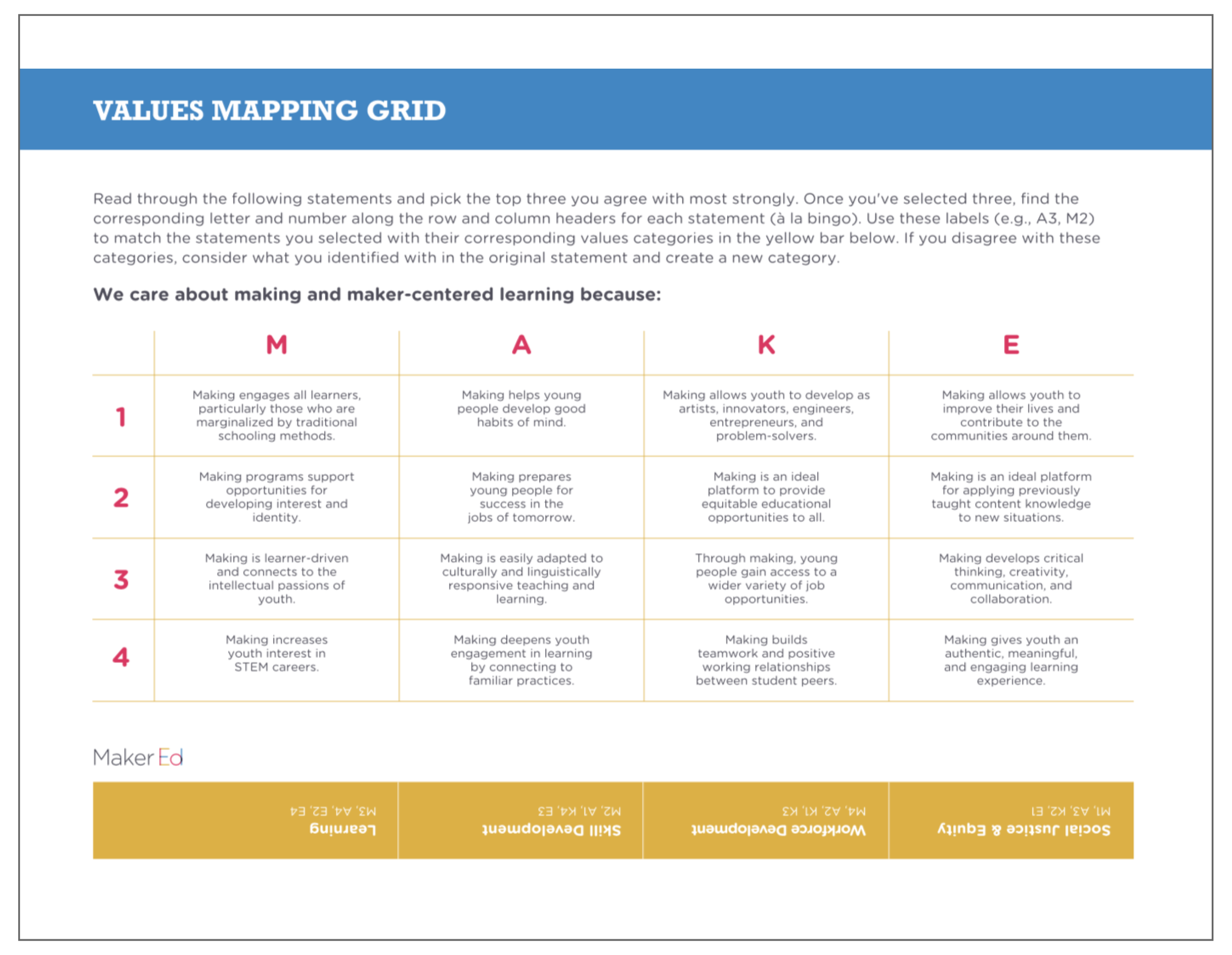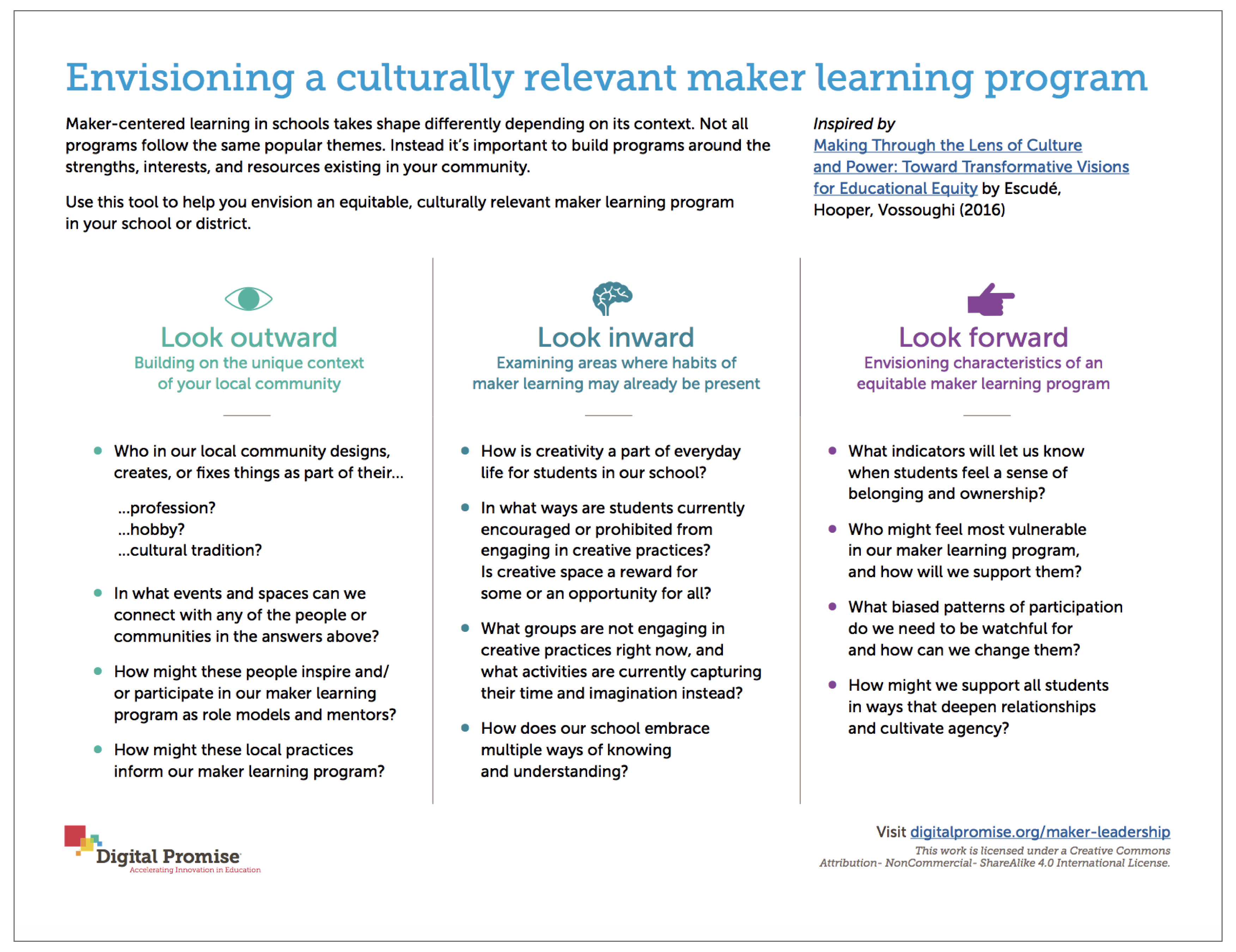Visioning provides a scaffold and centers the institution’s values as a way to define the “why” behind making and the “how” to implement. This module contains a foundational set of tools for visioning and planning any sort of maker-oriented programming, space, or curriculum. You’ll gain a clear picture of why you value maker-centered learning and a defined vision of your goals, audience, and how you’ll know you’ve been successful in reaching your goals. This module can be completed on your own; however, you’ll have a much richer discussion if this is a collaborative effort with colleagues and partners. In particular, we highly suggest the first activity be done with multiple people from your organization.
 Do
Do
Think about why you care about making and/or maker-centered learning.
If you’re doing this activity with a group, have everyone complete the exercise independently, then discuss with a partner.
On a sticky note, write down answers to these prompts (one answer per sticky note):
- I believe education is important because…
- I believe maker-centered learning is important because…
What do you notice about the similarities and differences in your answers? Should there be differences in the two?
Now, continue onto the next section. If you’re doing this activity with a group, have everyone complete the next Values Mapping exercise independently, then collectively mark one copy of the resource (below) and discuss the themes that emerged with the whole group.
 Read through the statements in Maker Ed’s Values Mapping Grid and pick the top three you agree with most strongly agree.
Read through the statements in Maker Ed’s Values Mapping Grid and pick the top three you agree with most strongly agree.
Once you’ve selected three statements, find the corresponding letter and number along the row and column headers (a la bingo) for each statement. Using these labels (e.g., A3, M2, etc.), match the statements you selected with their corresponding values categories (in yellow). If you disagree with these categories, consider what in the original statement you identified with, and create a new category.
Finally, pull together your collective thoughts for this last section. If you’re doing this activity with a group of colleagues at your organization, count up the number of votes for each category and use the top three themes.
Write a one-sentence vision statement that incorporates all of the themes from your chosen statements. This statement should reflect why you care about making and/or maker-centered learning.
 Reflect
Reflect
 Think about the maker-centered learning that currently exists in your community. Take a look at Digital Promise’s Envisioning a Culturally Relevant Maker Learning Program tool and reflect on the questions they pose in each category.
Think about the maker-centered learning that currently exists in your community. Take a look at Digital Promise’s Envisioning a Culturally Relevant Maker Learning Program tool and reflect on the questions they pose in each category.
Example:Before constructing your own vision statement, take a look at some of these examples of visions for maker-centered learning. The following links will take you to groups of schools who were supported by educational institutions running programs to develop maker-centered learning at schools. The Bubbler at Madison Public Library and the Scott Family Amazeum were in the first cohort of Making Spaces, a program that grew out of work done by the Children’s Museum of Pittsburgh in their Kickstarting Making campaign.
- The Bubbler at Madison Public Library’s 2018-19 Making Spaces school cohort
- The Scott Family Amazeum’s Making Spaces schools (The links for the first five schools will take you to their GoFundMe crowdfunding campaign videos.)
- The Children’s Museum of Pittsburgh’s Kickstarting Making in Schools
 Apply
Apply
Fill out the Making Spaces Vision Statement Tool. Your work from above should give you a starting point for the first two columns. The Planning: Stakeholders & Audience module can help you think through the third column.
 Do
Do
Use your work to create a concise vision statement, filling in the following statement in a Mad Libs style:
“We believe [values] and are supported by [community strengths]. We aim to [what] for [whom]. We’re doing this because [why], and we will succeed when [ _____ ].”
 Explore
Explore
- Who are the stakeholders who are or should be involved in this project? Take a look at the Planning: Stakeholders & Audience module to explore who to involve in this undertaking.
- What are all the parts and pieces you want to include? Take a look at the Planning: Pieces & Parts module to develop a common language across your team members related to important aspects of your makerspace or maker programs.
- How are you going to share your work with your community? Take a look at the Making the Case: Capturing Your Story module.
This module was developed in collaboration with Goli Mohammadi (editorial) and Kim Dow (design). Maker Ed would also like to thank Schmidt Futures for supporting the creation of these learning modules.
